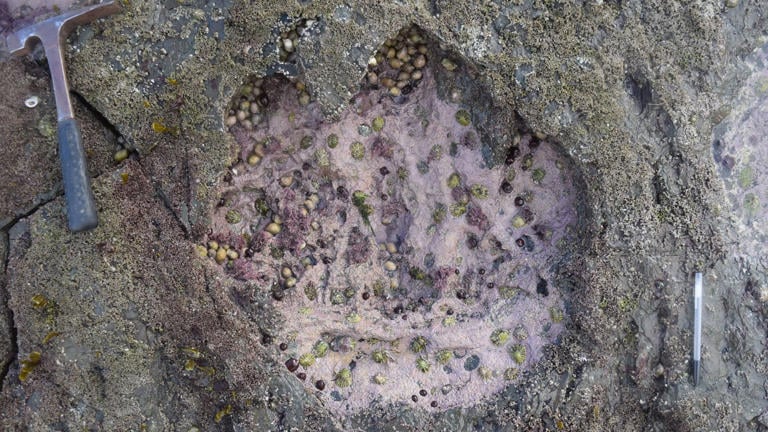Scientists have made fascinating discoveries on the Isle of Skye in Scotland, uncovering footprints from two distinct types of dinosaurs. These findings provide valuable insights into the evolutionary development and locomotion of these extinct creatures during the Jurassic era. The dinosaur traces were identified in the form of trackways as well as individual marks, shedding light on their movements and behaviors.
In April 2016, researchers Hong-Yu Yi and Davide Foffa first discovered the fossils on the Isle of Skye. The following year, paleontologist Dr. Stephen Brusatte from the University of Edinburgh, accompanied by his student Paige dePolo, returned to the site to conduct a detailed examination of the footprints and gather more information.
However, accessing the prints proved challenging as they were situated in the wave-exposed tidal zone of a headland known as Brother’s Point. A collaborative study involving the University of Edinburgh, Staffin Museum, and the Chinese Academy of Sciences was subsequently conducted under dePolo’s leadership.
On April 2, 2018, the findings of the study, accompanied by a comprehensive collection of 50 footprint images, were presented in the Scottish Journal of Geology.
After conducting a thorough analysis, the research team has determined that the tracks are approximately 170 million years old. Their findings indicate that these tracks were left behind by colossal creatures as they traversed a shallow lagoon.
The discovery offers a glimpse into the distant past when Earth underwent significant changes. It was a time when the supercontinent Pangaea began to separate, and our planet was in the process of forming the familiar continents we recognize today.
During that era, scientists speculate that the region of Skye was located within the subtropical zone, characterized by considerably warmer temperatures. Dr. Brusatte describes the environment as a paradise-like subtropical world, reminiscent of present-day locations such as Florida or Spain.
The recent discovery of dinosaur prints in Scotland has sparked immense excitement in the fields of paleontology and geology due to their origin in the Middle Jurassic epoch. This era holds great significance in the evolution of dinosaurs, as it is believed to be the time when the first birds emerged and the largest sauropod species flourished.
However, dinosaur fossils from this period are relatively rare compared to other periods, making these finds even more valuable. Notably, this discovery follows closely on the heels of another significant finding in 2015, where hundreds of Middle Jurassic sauropod tracks were unearthed at Duntulm Beach on the Isle of Skye. The prints at Brother’s Point are even older, originating from rocks predating the 2015 discovery.
The comprehensive study has greatly expanded our understanding of dinosaurs from the Middle Jurassic epoch and yielded valuable insights. It has been revealed that sauropods inhabited this region for a longer duration than previously believed.
During that era, sauropods were the largest terrestrial animals, despite their herbivorous nature. Notably, the research team not only documented the tracks of sauropods but also discovered distinct three-toed footprints belonging to theropods, which are distant and more primitive relatives of the Tyrannosaurus Rex. These carnivorous dinosaurs could reach heights of around 6.5 feet, adding to the diversity of dinosaur species present in the area.
The researchers faced numerous challenges during their studies. The relentless cold winds and rain in the area posed a constant obstacle, hindering the mapping process. Additionally, the presence of high tides posed a significant challenge as the footprints would be periodically submerged.
Consequently, the team had to carefully manage their time, diligently measuring and examining the tracks on the rocky ledges before they were reclaimed by the ocean.
Furthermore, the researchers had to improvise with their cameras and equipment to overcome these difficulties. Despite the hurdles, their efforts proved fruitful as they successfully generated 3D images of the terrain, enabling a more comprehensive understanding of the site.
According to Brusatte, a remarkable aspect of the dinosaur tracks discovered was the presence of handprints, providing evidence of the involvement of large creatures like sauropods. These massive animals, reaching lengths of up to 50 feet, relied on all four limbs to sustain their weight as they moved. In contrast, the theropod tracks suggested that these dinosaurs exclusively walked on their hind legs, showcasing their distinctive locomotion pattern.
Brusatte further acknowledged the potential existence of additional Middle Jurassic dinosaur fossils concealed within the Isle of Skye, suggesting that these recent discoveries might only scratch the surface of what this Scottish island holds in terms of dinosaur knowledge.











































